Abstract
We have studied the ability of rabies virus ribonucleoprotein (RNP) to induce a protective immune response in animals against lethal challenge with rabies and rabies-related lyssa viruses. Liposomes containing either RNP or the glycoprotein (G protein) of a variant virus with multiple alterations in the G antigenic structure conferred no or poor protection, respectively, against lethal intracerebral challenge with rabies virus. By contrast, liposomes containing RNP and the variant G protein induced a good protective response, comparable to that achieved with inactivated virus vaccine against intracerebral challenge. Moreover, mice or raccoons immunized with RNP alone resisted lethal peripheral challenge with homologous or heterologous virus strains. These results indicate that the RNP of rabies virus plays a crucial role in induction of protective immunity.
Full text
PDF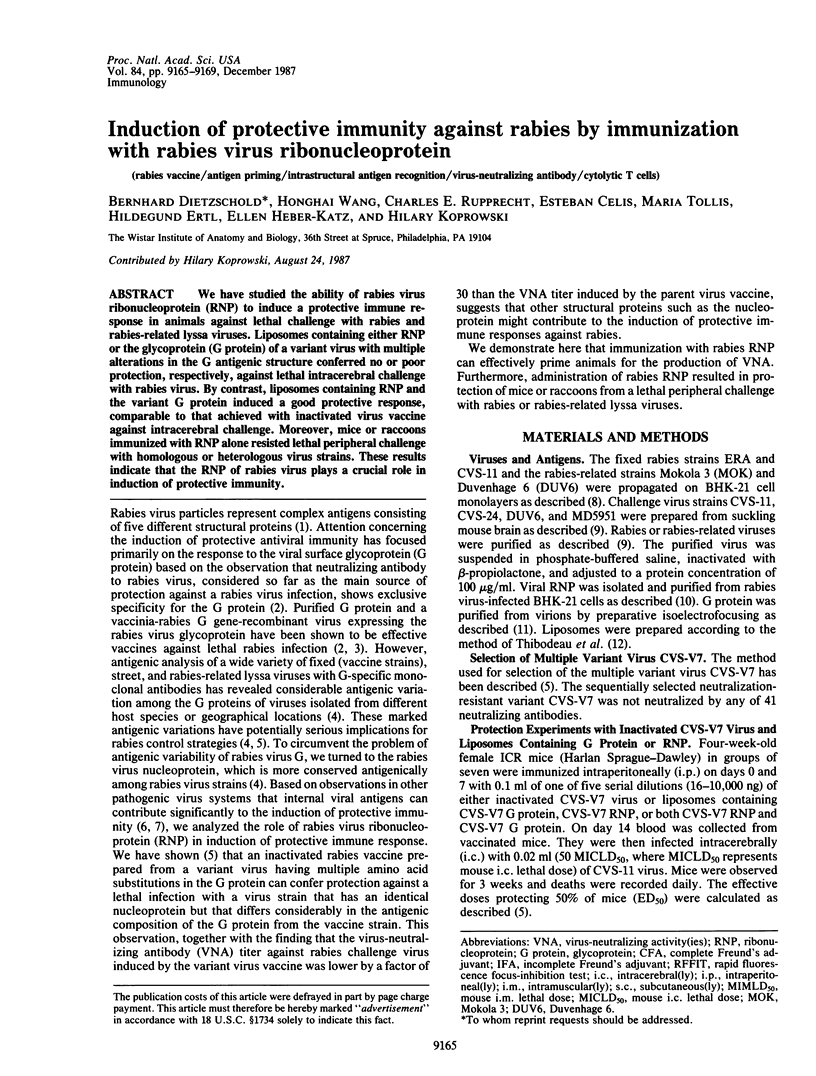
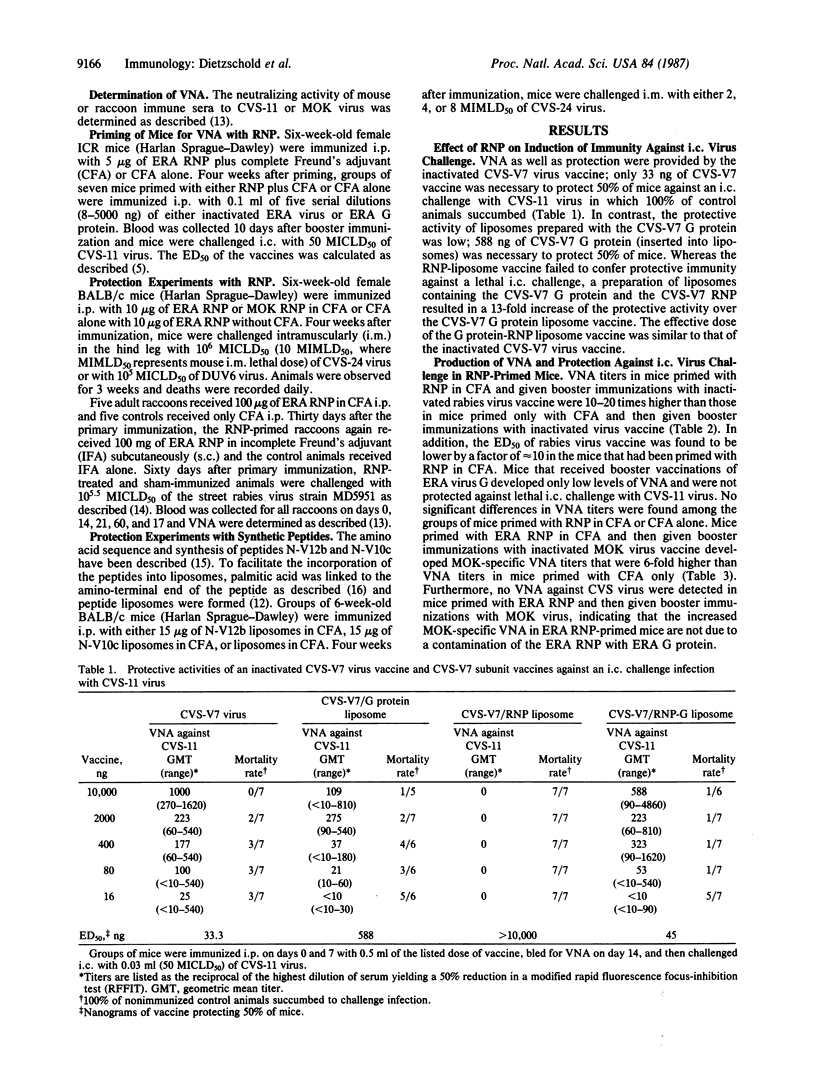
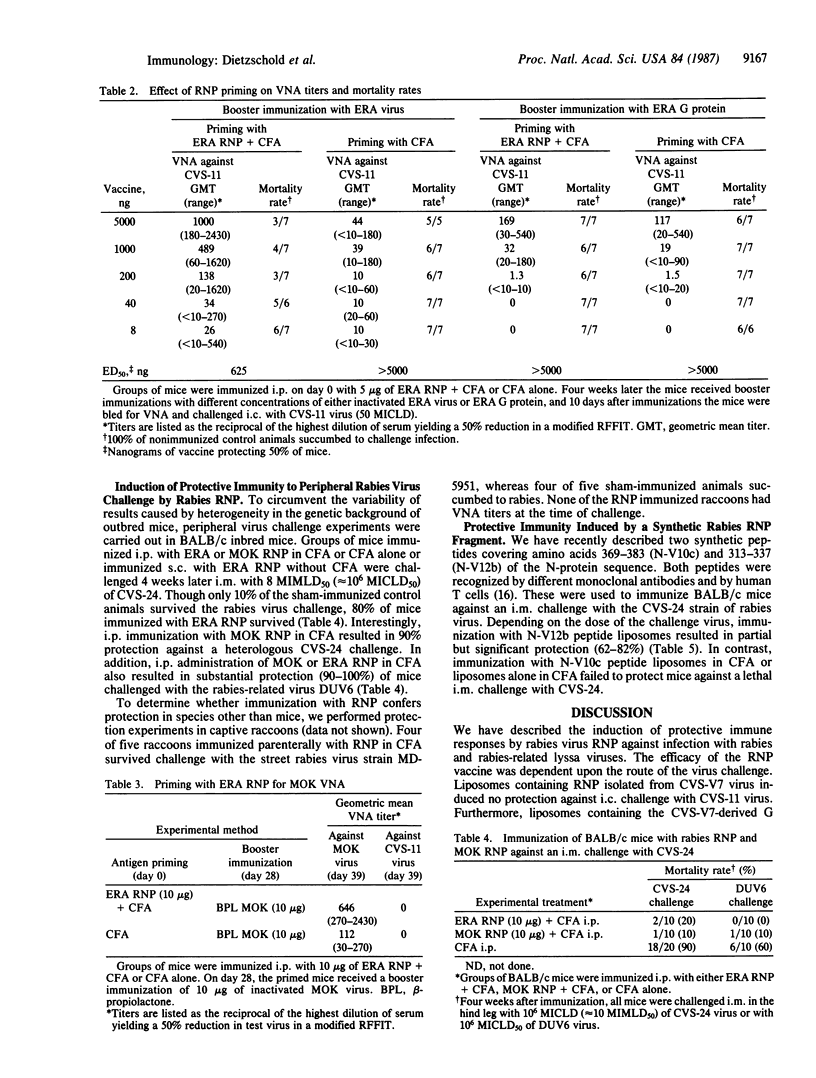
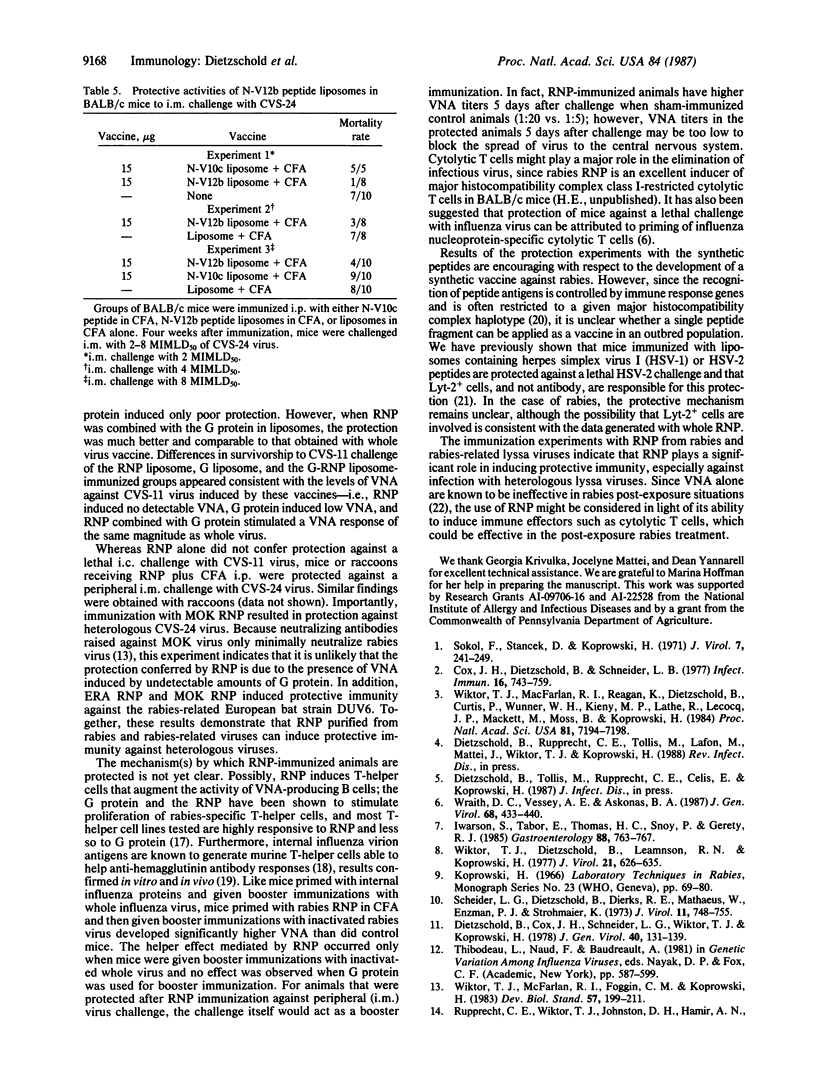
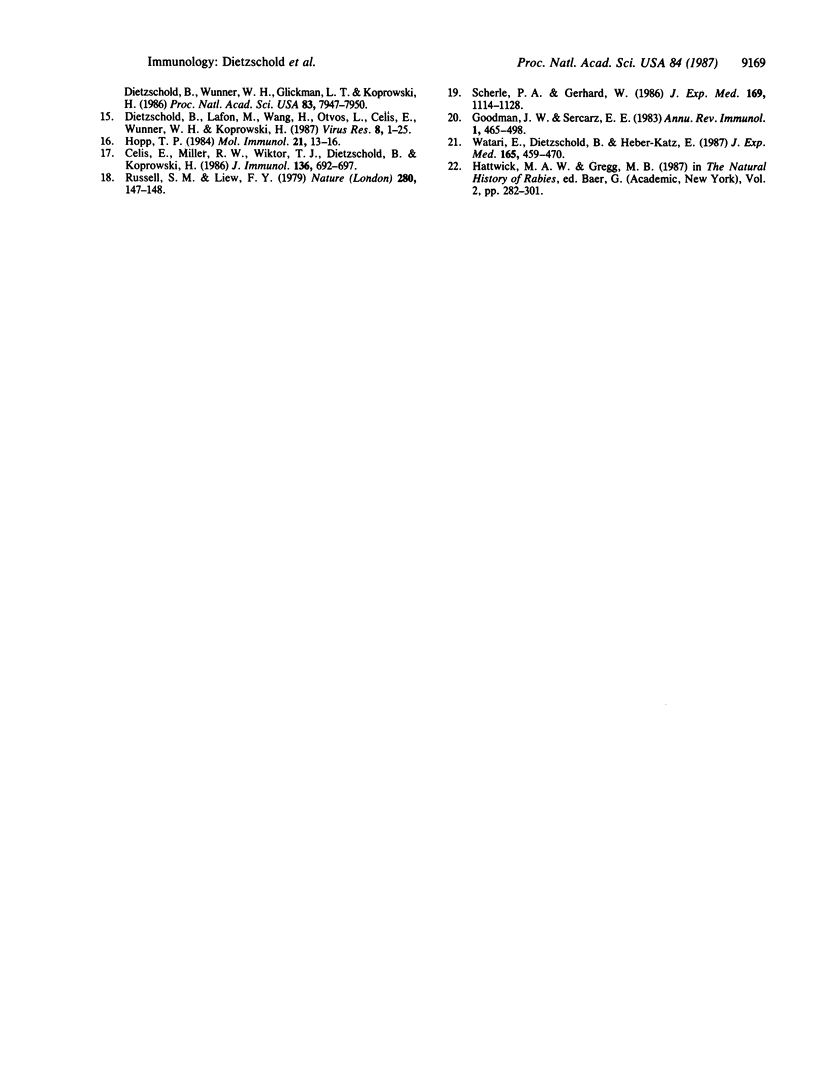
Selected References
These references are in PubMed. This may not be the complete list of references from this article.
- Celis E., Miller R. W., Wiktor T. J., Dietzschold B., Koprowski H. Isolation and characterization of human T cell lines and clones reactive to rabies virus: antigen specificity and production of interferon-gamma. J Immunol. 1986 Jan;136(2):692–697. [PubMed] [Google Scholar]
- Cox J. H., Dietzschold B., Schneider L. G. Rabies virus glycoprotein. II. Biological and serological characterization. Infect Immun. 1977 Jun;16(3):754–759. doi: 10.1128/iai.16.3.754-759.1977. [DOI] [PMC free article] [PubMed] [Google Scholar]
- Dietzschold B., Cox J. H., Schneider L. G., Wiktor T. J., Koprowski H. Isolation and purification of a polymeric form of the glycoprotein of rabies virus. J Gen Virol. 1978 Jul;40(1):131–139. doi: 10.1099/0022-1317-40-1-131. [DOI] [PubMed] [Google Scholar]
- Gerbaud S., Vialat P., Pardigon N., Wychowski C., Girard M., Bouloy M. The S segment of the Germiston virus RNA genome can code for three proteins. Virus Res. 1987 Jul;8(1):1–13. doi: 10.1016/0168-1702(87)90035-9. [DOI] [PubMed] [Google Scholar]
- Goodman J. W., Sercarz E. E. The complexity of structures involved in T-cell activation. Annu Rev Immunol. 1983;1:465–498. doi: 10.1146/annurev.iy.01.040183.002341. [DOI] [PubMed] [Google Scholar]
- Hopp T. P. Immunogenicity of a synthetic HBsAg peptide: enhancement by conjugation to a fatty acid carrier. Mol Immunol. 1984 Jan;21(1):13–16. doi: 10.1016/0161-5890(84)90084-1. [DOI] [PubMed] [Google Scholar]
- Iwarson S., Tabor E., Thomas H. C., Snoy P., Gerety R. J. Protection against hepatitis B virus infection by immunization with hepatitis B core antigen. Gastroenterology. 1985 Mar;88(3):763–767. doi: 10.1016/0016-5085(85)90148-9. [DOI] [PubMed] [Google Scholar]
- Koprowski H. Laboratory techniques in rabies. Mouse inoculation test. Monogr Ser World Health Organ. 1966;23:69–80. [PubMed] [Google Scholar]
- Rupprecht C. E., Wiktor T. J., Johnston D. H., Hamir A. N., Dietzschold B., Wunner W. H., Glickman L. T., Koprowski H. Oral immunization and protection of raccoons (Procyon lotor) with a vaccinia-rabies glycoprotein recombinant virus vaccine. Proc Natl Acad Sci U S A. 1986 Oct;83(20):7947–7950. doi: 10.1073/pnas.83.20.7947. [DOI] [PMC free article] [PubMed] [Google Scholar]
- Russell S. M., Liew F. Y. T cells primed by influenza virion internal components can cooperate in the antibody response to haemagglutinin. Nature. 1979 Jul 12;280(5718):147–148. doi: 10.1038/280147a0. [DOI] [PubMed] [Google Scholar]
- Scherle P. A., Gerhard W. Functional analysis of influenza-specific helper T cell clones in vivo. T cells specific for internal viral proteins provide cognate help for B cell responses to hemagglutinin. J Exp Med. 1986 Oct 1;164(4):1114–1128. doi: 10.1084/jem.164.4.1114. [DOI] [PMC free article] [PubMed] [Google Scholar]
- Schneider L. G., Dietzschold B., Dierks R. E., Matthaeus W., Enzmann P. J., Strohmaier K. Rabies group-specific ribonucleoprotein antigen and a test system for grouping and typing of rhabdoviruses. J Virol. 1973 May;11(5):748–755. doi: 10.1128/jvi.11.5.748-755.1973. [DOI] [PMC free article] [PubMed] [Google Scholar]
- Sokol F., Stancek D., Koprowski H. Structural proteins of rabies virus. J Virol. 1971 Feb;7(2):241–249. doi: 10.1128/jvi.7.2.241-249.1971. [DOI] [PMC free article] [PubMed] [Google Scholar]
- Watari E., Dietzschold B., Szokan G., Heber-Katz E. A synthetic peptide induces long-term protection from lethal infection with herpes simplex virus 2. J Exp Med. 1987 Feb 1;165(2):459–470. doi: 10.1084/jem.165.2.459. [DOI] [PMC free article] [PubMed] [Google Scholar]
- Wiktor T. J., Dietzschold B., Leamnson R. N., Koprowski H. Induction and biological properties of defective interfering particles of rabies virus. J Virol. 1977 Feb;21(2):626–635. doi: 10.1128/jvi.21.2.626-635.1977. [DOI] [PMC free article] [PubMed] [Google Scholar]
- Wiktor T. J., Macfarlan R. I., Foggin C. M., Koprowski H. Antigenic analysis of rabies and Mokola virus from Zimbabwe using monoclonal antibodies. Dev Biol Stand. 1984;57:199–211. [PubMed] [Google Scholar]
- Wiktor T. J., Macfarlan R. I., Reagan K. J., Dietzschold B., Curtis P. J., Wunner W. H., Kieny M. P., Lathe R., Lecocq J. P., Mackett M. Protection from rabies by a vaccinia virus recombinant containing the rabies virus glycoprotein gene. Proc Natl Acad Sci U S A. 1984 Nov;81(22):7194–7198. doi: 10.1073/pnas.81.22.7194. [DOI] [PMC free article] [PubMed] [Google Scholar]
- Wraith D. C., Vessey A. E., Askonas B. A. Purified influenza virus nucleoprotein protects mice from lethal infection. J Gen Virol. 1987 Feb;68(Pt 2):433–440. doi: 10.1099/0022-1317-68-2-433. [DOI] [PubMed] [Google Scholar]


